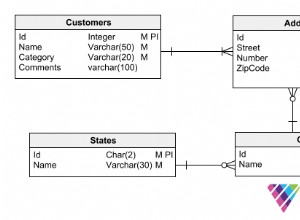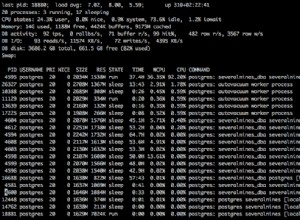Có một số giải pháp. Trước hết, tôi sẽ sử dụng dữ liệu sau (categories bảng) làm ví dụ.
+----+--------------------------+-----------+
| id | name | parent_id |
+----+--------------------------+-----------+
| 1 | Electronics | NULL |
| 2 | Apparel & Clothing | NULL |
| 3 | Phones & Accessories | 1 |
| 4 | Computer & Office | 1 |
| 5 | Men's Clothing | 2 |
| 6 | Women's Clothing | 2 |
| 7 | Cell Phones | 3 |
| 8 | Cell Phone Accessories | 3 |
| 9 | Phone Parts | 3 |
| 10 | Computers & Accessories | 4 |
| 11 | Tablets & Accessories | 4 |
| 12 | Computer Peripherals | 4 |
| 13 | Computer Components | 4 |
| 14 | Office Electronics | 4 |
+----+--------------------------+-----------+
Giải pháp 1 ( Danh sách gần kề ):
Bạn có thể dễ dàng tìm nạp tất cả các danh mục hoặc danh mục con của một danh mục trong một truy vấn duy nhất bằng cách sử dụng WITH (Biểu thức Bảng Phổ biến) mệnh đề (yêu cầu MySQL 8.0):
// Database connection
$options = [
PDO::ATTR_DEFAULT_FETCH_MODE => PDO::FETCH_ASSOC,
PDO::ATTR_EMULATE_PREPARES => false,
PDO::ATTR_ERRMODE => PDO::ERRMODE_EXCEPTION,
];
$pdo = new PDO('mysql:host=localhost;dbname=<DATABASE_NAME>', '<USERNAME>', '<PASSWORD>', $options);
function getCategories(PDO $db, $parentId = null)
{
$sql = $parentId ? 'WITH RECURSIVE cte (id, name, parent_id) AS (SELECT id, name, parent_id FROM categories WHERE parent_id = ? UNION ALL SELECT c.id, c.name, c.parent_id FROM categories c INNER JOIN cte ON c.parent_id = cte.id) SELECT * FROM cte' : 'SELECT * FROM categories';
$stmt = $db->prepare($sql);
$stmt->execute($parentId ? [$parentId] : null);
return $stmt->fetchAll();
}
Nếu bạn đang sử dụng MySQL 5.7, hãy thay đổi chức năng đó như sau:
function getCategories(PDO $db, $parentId = null)
{
$sql = $parentId ? 'SELECT id, name, parent_id FROM (SELECT * FROM categories ORDER BY parent_id, id) c, (select @pv := ?) initialisation WHERE find_in_set(parent_id, @pv) AND LENGTH(@pv := concat(@pv, ",", id))' : 'SELECT * FROM categories';
$stmt = $db->prepare($sql);
$stmt->execute($parentId ? [$parentId] : null);
return $stmt->fetchAll();
}
Để nhận tất cả các danh mục trong cơ sở dữ liệu của bạn:
$allCategories = getCategories($pdo);
Đầu ra:
+----+--------------------------+-----------+
| id | name | parent_id |
+----+--------------------------+-----------+
| 1 | Electronics | NULL |
| 2 | Apparel & Clothing | NULL |
| 3 | Phones & Accessories | 1 |
| 4 | Computer & Office | 1 |
| 5 | Men's Clothing | 2 |
| 6 | Women's Clothing | 2 |
| 7 | Cell Phones | 3 |
| 8 | Cell Phone Accessories | 3 |
| 9 | Phone Parts | 3 |
| 10 | Computers & Accessories | 4 |
| 11 | Tablets & Accessories | 4 |
| 12 | Computer Peripherals | 4 |
| 13 | Computer Components | 4 |
| 14 | Office Electronics | 4 |
+----+--------------------------+-----------+
Để nhận các danh mục phụ của một danh mục:
$subCategories = getCategories($pdo, 1); // 1 is parent_id
Đầu ra:
+----+--------------------------+-----------+
| id | name | parent_id |
+----+--------------------------+-----------+
| 3 | Phones & Accessories | 1 |
| 4 | Computer & Office | 1 |
| 7 | Cell Phones | 3 |
| 8 | Cell Phone Accessories | 3 |
| 9 | Phone Parts | 3 |
| 10 | Computers & Accessories | 4 |
| 11 | Tablets & Accessories | 4 |
| 12 | Computer Peripherals | 4 |
| 13 | Computer Components | 4 |
| 14 | Office Electronics | 4 |
+----+--------------------------+-----------+
Nếu bạn muốn đầu ra HTML, bạn có thể lặp qua $allCategories / $subCategories (dựa trên ví dụ của bạn):
function prepareCategories(array $categories)
{
$result = [
'all_categories' => [],
'parent_categories' => []
];
foreach ($categories as $category) {
$result['all_categories'][$category['id']] = $category;
$result['parent_categories'][$category['parent_id']][] = $category['id'];
}
return $result;
}
function buildCategories($categories, $parentId = null)
{
if (!isset($categories['parent_categories'][$parentId])) {
return '';
}
$html = '<ul>';
foreach ($categories['parent_categories'][$parentId] as $cat_id) {
if (isset($categories['parent_categories'][$cat_id])) {
$html .= "<li><a href='#'>{$categories['all_categories'][$cat_id]['name']}</a>";
$html .= buildCategories($categories, $cat_id);
$html .= '</li>';
} else {
$html .= "<li><a href='#'>{$categories['all_categories'][$cat_id]['name']}</a></li>";
}
}
$html .= '</ul>';
return $html;
}
echo buildCategories(prepareCategories($allCategories));
Đầu ra:
echo buildCategories(prepareCategories($subCategories), 1);
Đầu ra:
Giải pháp 2 ( Bộ lồng nhau ):
Chúng tôi sẽ thêm các cột bổ sung left và right vào bảng của chúng tôi và đặt các số vào đó sẽ xác định các nhóm thuộc nhóm gốc. (Lưu ý rằng chúng tôi sẽ không sử dụng parent_id cột.)
+----+--------------------------+--------------------------+
| id | name | parent_id | left | right |
+----+--------------------------+--------------------------+
| 1 | Electronics | NULL | 1 | 22 |
| 2 | Apparel & Clothing | NULL | 23 | 28 |
| 3 | Phones & Accessories | 1 | 2 | 9 |
| 4 | Computer & Office | 1 | 10 | 21 |
| 5 | Men's Clothing | 2 | 24 | 25 |
| 6 | Women's Clothing | 2 | 26 | 27 |
| 7 | Cell Phones | 3 | 3 | 4 |
| 8 | Cell Phone Accessories | 3 | 5 | 6 |
| 9 | Phone Parts | 3 | 7 | 8 |
| 10 | Computers & Accessories | 4 | 11 | 12 |
| 11 | Tablets & Accessories | 4 | 13 | 14 |
| 12 | Computer Peripherals | 4 | 15 | 16 |
| 13 | Computer Components | 4 | 17 | 18 |
| 14 | Office Electronics | 4 | 19 | 20 |
+----+--------------------------+--------------------------+
Bây giờ, chúng ta cần thay đổi chức năng của mình:
function getCategories(PDO $db, $parentId = null)
{
$sql = $parentId ? 'SELECT children.* FROM categories parent INNER JOIN categories children ON parent.left < children.left AND parent.right > children.left WHERE parent.id = ?' : 'SELECT * FROM categories';
$stmt = $db->prepare($sql);
$stmt->execute($parentId ? [$parentId] : null);
return $stmt->fetchAll();
}
Để nhận tất cả các danh mục trong cơ sở dữ liệu của bạn:
$allCategories = getCategories($pdo);
Đầu ra:
+----+--------------------------+--------------------------+
| id | name | parent_id | left | right |
+----+--------------------------+--------------------------+
| 1 | Electronics | NULL | 1 | 22 |
| 2 | Apparel & Clothing | NULL | 23 | 28 |
| 3 | Phones & Accessories | 1 | 2 | 9 |
| 4 | Computer & Office | 1 | 10 | 21 |
| 5 | Men's Clothing | 2 | 24 | 25 |
| 6 | Women's Clothing | 2 | 26 | 27 |
| 7 | Cell Phones | 3 | 3 | 4 |
| 8 | Cell Phone Accessories | 3 | 5 | 6 |
| 9 | Phone Parts | 3 | 7 | 8 |
| 10 | Computers & Accessories | 4 | 11 | 12 |
| 11 | Tablets & Accessories | 4 | 13 | 14 |
| 12 | Computer Peripherals | 4 | 15 | 16 |
| 13 | Computer Components | 4 | 17 | 18 |
| 14 | Office Electronics | 4 | 19 | 20 |
+----+--------------------------+--------------------------+
Để nhận các danh mục phụ của một danh mục:
$subCategories = getCategories($pdo, 1); // 1 is parent_id
Đầu ra:
+----+--------------------------+--------------------------+
| id | name | parent_id | left | right |
+----+--------------------------+--------------------------+
| 3 | Phones & Accessories | 1 | 2 | 9 |
| 4 | Computer & Office | 1 | 10 | 21 |
| 7 | Cell Phones | 3 | 3 | 4 |
| 8 | Cell Phone Accessories | 3 | 5 | 6 |
| 9 | Phone Parts | 3 | 7 | 8 |
| 10 | Computers & Accessories | 4 | 11 | 12 |
| 11 | Tablets & Accessories | 4 | 13 | 14 |
| 12 | Computer Peripherals | 4 | 15 | 16 |
| 13 | Computer Components | 4 | 17 | 18 |
| 14 | Office Electronics | 4 | 19 | 20 |
+----+--------------------------+--------------------------+
Bạn có thể hiển thị HTML như được hiển thị trong Giải pháp 1 . Đọc thêm về cập nhật và chèn dữ liệu mới trong mô hình tập hợp lồng nhau.
Nguồn &Đọc:
- Quản lý dữ liệu phân cấp trong MySQL - tập hợp lồng nhau
- Quản lý dữ liệu phân cấp trong MySQL
- Mô hình cho dữ liệu phân cấp
- Quản lý dữ liệu phân cấp trong MySQL bằng mô hình danh sách gần kề
- Danh sách gần kề so với các tập hợp lồng nhau:MySQL
- Một nhiều Khoảng lồng nhau hơn so với so sánh Danh sách gần kề








